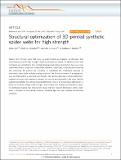Structural optimization of 3D-printed synthetic spider webs for high strength
Author(s)
Qin, Zhao; Compton, Brett G.; Lewis, Jennifer A.; Buehler, Markus J
DownloadBuehler_Structural optimization.pdf (2.117Mb)
PUBLISHER_CC
Publisher with Creative Commons License
Creative Commons Attribution
Terms of use
Metadata
Show full item recordAbstract
Spiders spin intricate webs that serve as sophisticated prey-trapping architectures that simultaneously exhibit high strength, elasticity and graceful failure. To determine how web mechanics are controlled by their topological design and material distribution, here we create spider-web mimics composed of elastomeric filaments. Specifically, computational modelling and microscale 3D printing are combined to investigate the mechanical response of elastomeric webs under multiple loading conditions. We find the existence of an asymptotic prey size that leads to a saturated web strength. We identify pathways to design elastomeric material structures with maximum strength, low density and adaptability. We show that the loading type dictates the optimal material distribution, that is, a homogeneous distribution is better for localized loading, while stronger radial threads with weaker spiral threads is better for distributed loading. Our observations reveal that the material distribution within spider webs is dictated by the loading condition, shedding light on their observed architectural variations.
Date issued
2015-05Department
Massachusetts Institute of Technology. Center for Computational Engineering; Massachusetts Institute of Technology. Department of Civil and Environmental Engineering; Massachusetts Institute of Technology. Laboratory for Atomistic and Molecular MechanicsJournal
Nature Communications
Publisher
Nature Publishing Group
Citation
Qin, Zhao, Brett G. Compton, Jennifer A. Lewis, and Markus J. Buehler. “Structural Optimization of 3D-Printed Synthetic Spider Webs for High Strength.” Nature Communications 6 (May 15, 2015): 7038. © 2015 Macmillan Publishers Limited
Version: Final published version
ISSN
2041-1723